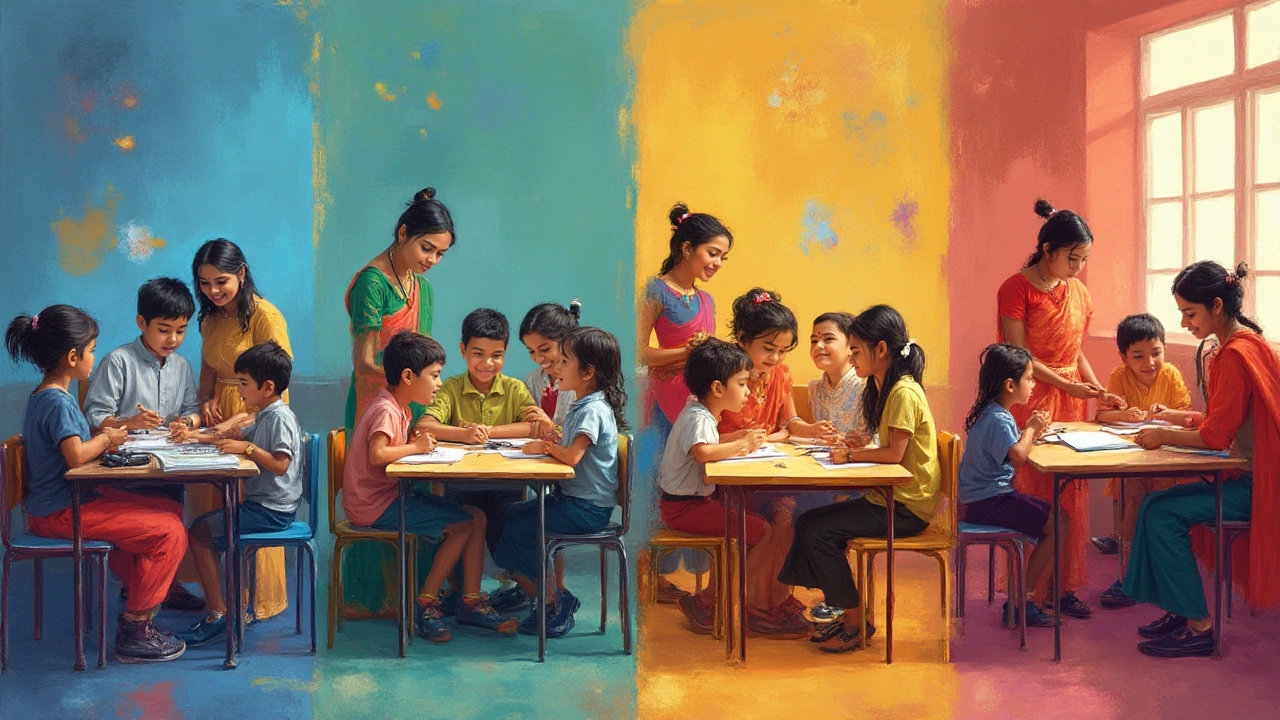
Why does picking the right school board for your child sometimes feel like buying a car you can't test drive? Parents swap stories on WhatsApp, teachers offer cautiously vague suggestions, and every school insists their board is best. Yet, this decision actually tweaks the wiring of your child's early mindset, not just their grades. So, is it really about chasing global fame? Or should you pick what's simple and fits your kid's pace? The facts, as it turns out, are a circus of competition, learning styles, and future dreams, all standing on four letters: CBSE, ICSE, IB, and State Board. Let’s break down the crossroads in plain-speak.
Unpacking the Big Four: CBSE, ICSE, IB, and State Boards
If you’ve ever seen school brochures, you’ll know these acronyms: CBSE. ICSE. IB. State Board. They sound catchy (official even) but what do they actually do differently for your child? The Central Board of Secondary Education (CBSE) is India’s most widespread board. Think lots of maths, science, and a practical syllabus designed for big public exams — especially handy if your child might move cities or dreams of cracking national entrance tests like the JEE or NEET. Practical fact: As of 2023, over 24,000 schools worldwide follow CBSE, making transfer easier if you’re likely to relocate.
Then there’s the Indian Certificate of Secondary Education (ICSE). It’s the drama kid of the school board world. Language skills, arts, group projects, and in-depth content rule here. The Cambridge IGCSE board often gets lumped in here, but ICSE is unique. Kids slog it out with essays and structured answers, so strong English is a must. Families with creative kids or those eyeing foreign universities often pump for this one. A study from the British Council in 2022 showed ICSE graduates have a noticeably higher rate of admission to UK colleges because of their deep focus on English and project work.
The International Baccalaureate (IB) doubles down on independent thinking, real-world assignments, and international-mindedness — a mouthful, but it simply means students do a ton of self-driven projects and reflection. It’s got three stages: PYP (Primary Years Programme), MYP (Middle Years Programme), and DP (Diploma Programme). Kids in IB often become the sort with opinions — sometimes annoyingly so! But they also pick up amazing research habits early. The World Economic Forum notes that students with IB backgrounds do better at university-level debates and presentations, thanks to the focus on inquiry skills.
State Boards, meanwhile, are a mixed bag since each Indian state runs its own show. Fees are lower, books are less dense, and exams usually focus on memorization over analytical thinking. Local culture shines, but gaps can emerge if you plan to shift states, as curricula shift wildly. They’re perfect for families wanting neighborhood schools, regional languages, or less academic stress. A 2021 survey by the National Institute of Educational Planning and Administration found more than half of rural families prefer state boards due to cost, language, and proximity.
All these boards are officially recognized by universities at home and abroad. However, some, like the IB and ICSE, have an edge when applying overseas, while CBSE is king for Indian standardized tests.
How Boards Shape Your Child: Learning, Exams, and Skill-Building
Let’s get honest: not every curriculum fits every kid. If your child practically lives in their science kit, CBSE’s focus will probably feel like home. Math and rote facts are drilled till they stick, handy for cracking those high-voltage entrance tests. Yet, the trade-off is CBSE may gloss over in-depth research or creative writing. According to the National Testing Agency, students from CBSE backgrounds showed the highest success rate in India’s NEET and JEE exams in 2023, at nearly 82% of top scorers.
ICSE throws a curve. Here, it’s about understanding rather than just remembering. More subjects mean more homework, that’s true — but also broader learning. English gets love like nowhere else, right down to grammar, essays, and critical literature. Kids who thrive here are often wordsmiths or the “curious explorer” types. It can get demanding: ICSE exams expect neat, structured written answers, and creative projects aren’t optional. If your kiddo’s aim is international academics, ICSE can open a lot of doors, as European and UK universities often ask for proof of advanced English, which the ICSE curriculum delivers in spades.
IB shifts the lens again. Think fewer exams, more research, lots of group work and presentations. Kids here often build portfolios, not just fill test sheets. The aim is to create thinkers who question everything — which in real life, means your child may quiz your dinner menu for sustainability. The New Zealand Ministry of Education highlights IB’s global focus, which is a bonus for youngsters aiming for universities in North America, UK, or Australia. They point to IB’s requirement of creativity and service (CAS activities) as helping students build real-world skills as early as age 10.
State Boards are geared to the local crowd. Teachers often explain concepts in the local language, and textbooks can be less daunting. If your family is planning to stay rooted, or if cost is a concern, this path is a solid bet. The workload is less chaotic, but be ready to support your child with extra coaching if they’re aiming for tough entrance tests or out-of-state universities. State board toppers often shine in regional competitive exams, but may need to bridge gaps when competing nationally or internationally.
Here’s a good rule of thumb: Match the board to your child’s natural bent. Rote learners or science enthusiasts? Go CBSE. Budding writers or debaters? ICSE’s for you. Big-picture thinkers or would-be global citizens? IB will challenge and reward. Fuss-free, locally-rooted? State Board offers a lighter touch. “Education is not the learning of facts, but the training of the mind to think,” Albert Einstein once remarked. It’s a handy mantra when narrowing down your options.
Whatever the path, remember: board exams are important, but so is growing up happy. The stress of constantly shifting gears for the “perfect” syllabus can leave even the brightest kids spinning. Take learning style and family situation just as seriously as university plans.

The Hidden Details: Recognitions, Transfers, Career Impact, and Fees
The devil is always in the detail. Yes, all these boards are “recognized,” but how does that play out on report cards, transfers, and fees?
CBSE is the default for families expecting job transfers or with moving plans. With a standardized syllabus, kids find it easier to slot into a new CBSE school mid-year — whether you’re bouncing between Delhi and Dubai or Mumbai and Muscat. Most Olympiads, scholarships, and central tests like NTSE or KVPY are mapped on the CBSE syllabus.
ICSE, on the other hand, isn’t as widely spread. Good schools exist in all major cities, but fewer in smaller towns. Transfers can get hairy if your new city doesn’t have an ICSE school. Fees also usually run a notch higher, thanks to “extras” like project supplies, frequent events, or premium campuses. But for the family wanting a deep dive into literature and diverse subjects, it’s worth every penny.
IB schools are the costliest. You’re paying for global teachers, fancy facilities, and low student-teacher ratios. Annual fees can run into lakhs — only a handful exist in most cities. Transfers abroad get simple, but in India, IB to Indian board transitions can be tough, especially for grades 10 and 12. If your child might switch to CBSE or ICSE for key exams, be ready to bridge gaps in content and exam style.
State Boards lead on affordability. “Our monthly school bill is less than the petrol cost for my friend’s school run,” joked a parent from Assam State Board last year. Local job quota schemes often give State Board students an edge. But if your kid wants to swing for central exams or shift overseas, you’ll need extra coaching or prep classes, since the syllabi often don’t completely match national or international tests.
The University Grants Commission (UGC) and most foreign universities accept all mainstream Indian boards for admissions — with caveats. Some UK universities ask for ICSE or IB-level English, while US colleges glance at IB projects for extra points. Watch out for this if overseas study is on your radar.
Transfers are smoothest within the same board. A mid-year ICSE-to-CBSE switch, for instance, might throw your kid into the deep end, especially given the difference in subjects and marking systems. Try to commit to a board for at least 4-5 years to avoid academic whiplash. And before switching, check the receiving school’s admissions criteria; some demand entrance tests even for lateral entries.
Don’t forget certifications and marksheets. If you return to India after time abroad, foreign-report cards need ratification from the local board office, which sometimes drags on for months.
Summing up: local stability, entrance exams, and future international plans — each changes the math of fees, paperwork, and stress. Smart tip: build a spreadsheet and call the schools themselves. Honest answers beat slick marketing.
Real-World Tips: Making the Smartest Board Decision
Getting buried under advice is easy. Instead, here’s how to slice through the fog.
- Zero in on your child’s learning style. Is your kid a bookworm, artist, scientist, or jack-of-all-trades? Do they panic in tests or thrive on competition? Match the board to this instinct, not just to 'what everyone else is doing.'
- Get hands-on with the syllabus. Download sample textbooks or old exam papers from official sites. If your grown-up self finds the texts interesting, your child probably will too.
- Visit the schools, not just their websites. Talk to teachers. Ask about classroom projects, not just marks. True stories from current parents give you the real scoop — dress rehearsals, science fairs, or how teachers help during tough weeks.
- Pressure check the fees. Don’t just calculate tuition: add up uniforms, books, trips, and extra coaching. Some boards’ hidden costs sneak up quickly.
- Consider campus culture. Are sports, music, or languages encouraged? Or is it just tuition and homework every night? Clubs and outdoor time do wonders for confidence.
- Plan long-term, but not forever. If there’s a chance of moving cities or countries in the next five years, prioritize transfer-friendly boards like CBSE or IB.
- Ask about board transitions. If shifting is likely, check how often the school helps with curriculum bridges or catch-up classes.
- Network with alumni. They’ll tell you if the school spirit is supportive or if it’s all about marks and comparison.
- If your family has siblings, see whether one board can serve both ages. It simplifies life for everyone, from holidays to homework help.
- Keep the pressure off. “No board guarantees success,” says Dr. Maya Pillai, education researcher from the Tata Institute of Social Sciences.
“What matters most is whether the child feels seen, heard, and encouraged to ask questions. The board becomes the tool, not the master.”
When you look past the brochures, the best board isn’t a trophy on the wall. It’s about helping your child wake up happy for school, curious about life, and confident to chase their dreams — whether those dreams involve medical school, a dance studio, or something you don’t even see coming yet. Choose the board by the fit, not the hype. That’s the secret sauce — not in headlines, just in the day-to-day smiles and less drama at the kitchen table.




